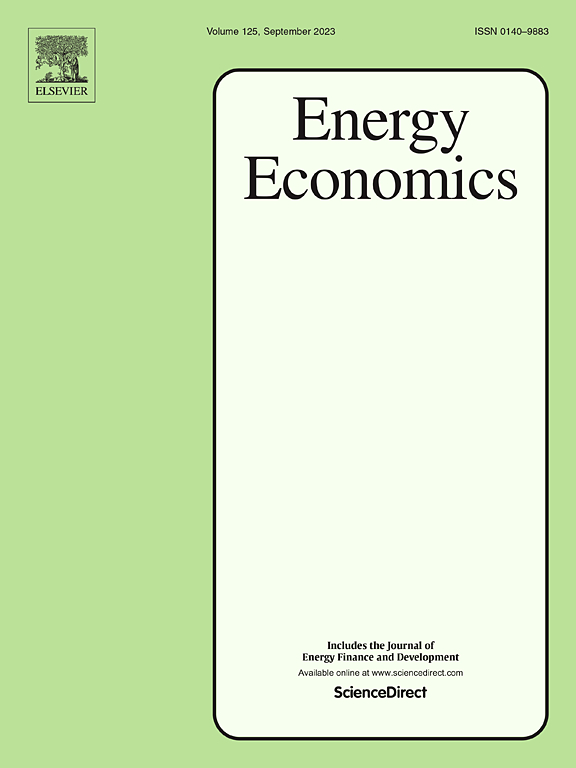释放协同效应:中国节能规制下企业绿色创新决策的协同演化机制
IF 14.2
2区 经济学
Q1 ECONOMICS
引用次数: 0
摘要
发展中国家普遍实施节能法规,以减少能源消耗和提高效率。然而,由于法规未能激励绿色创新,受监管的企业可能会优先考虑减少产量而不是提高能源效率,因此它们的有效性往往有限。先前的研究讨论了此类监管对绿色创新的直接影响,结果好坏参半,往往忽视了企业之间的竞争动态以及对不受监管企业的间接影响,这可能会影响结果并损害整体节能努力。本研究以中国的两项国家节能措施为原型,引入了一个二人进化博弈模型来分析这些法规的直接和间接影响。该模型将竞争动力学分解为生产竞争和绿色创新竞争,并确定了监管能够实现双重目标的关键条件,突出了较强的趋同效应和略低于阈值的适当监管强度。通过异质性和敏感性分析,我们发现针对能效较高的企业、市场集中度较高的行业、增强规制前的创新意愿、放大绿色创新的市场效益能够有效促进绿色创新。我们的框架为优化节能法规提供了见解,以发挥降低能耗和提高能效之间的协同作用,并在受监管和不受监管的企业中促进绿色创新。本文章由计算机程序翻译,如有差异,请以英文原文为准。
Unlocking synergy: The coevolution mechanism of enterprises' green innovation decisions under China's energy-saving regulations
Energy-saving regulations are commonly implemented in developing countries to reduce energy consumption and enhance efficiency. Yet, their effectiveness is often limited as regulated enterprises may prioritize output reductions over enhancements in energy efficiency due to the regulations' failure to incentivize green innovation. Prior research debates the direct impacts of such regulations on green innovation, with mixed findings, often overlooking the competitive dynamics between enterprises and indirect impacts on unregulated enterprises, which can bias results and harm overall energy conservation efforts. In this study, using China's two national energy-saving initiatives as prototypes, we introduce a two-player evolutionary game model to analyze both the direct and indirect impacts of these regulations. This model deconstructs competitive dynamics into production competition and green innovation competition, and identifies key conditions under which regulations can achieve dual goals, highlighting a strong convergence effect and an appropriate regulatory intensity that slightly below the threshold. Through heterogeneity and sensitivity analyses, our findings suggest that targeting enterprises with high energy efficiency, industries with significant market concentration, enhancing innovation intention before regulation, and amplifying the market benefits of green innovation effectively promote green innovation. Our framework offers insights for optimizing energy-saving regulations to unlock synergy between reducing energy consumption and enhancing energy efficiency, as well as fostering green innovation among both regulated and unregulated enterprises.
求助全文
通过发布文献求助,成功后即可免费获取论文全文。
去求助
来源期刊

Energy Economics
ECONOMICS-
CiteScore
18.60
自引率
12.50%
发文量
524
期刊介绍:
Energy Economics is a field journal that focuses on energy economics and energy finance. It covers various themes including the exploitation, conversion, and use of energy, markets for energy commodities and derivatives, regulation and taxation, forecasting, environment and climate, international trade, development, and monetary policy. The journal welcomes contributions that utilize diverse methods such as experiments, surveys, econometrics, decomposition, simulation models, equilibrium models, optimization models, and analytical models. It publishes a combination of papers employing different methods to explore a wide range of topics. The journal's replication policy encourages the submission of replication studies, wherein researchers reproduce and extend the key results of original studies while explaining any differences. Energy Economics is indexed and abstracted in several databases including Environmental Abstracts, Fuel and Energy Abstracts, Social Sciences Citation Index, GEOBASE, Social & Behavioral Sciences, Journal of Economic Literature, INSPEC, and more.
 求助内容:
求助内容: 应助结果提醒方式:
应助结果提醒方式:


